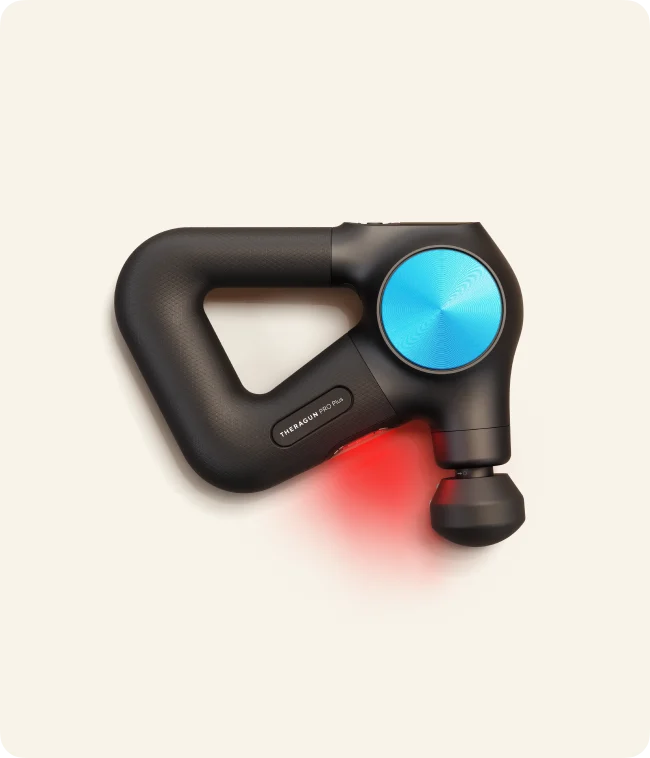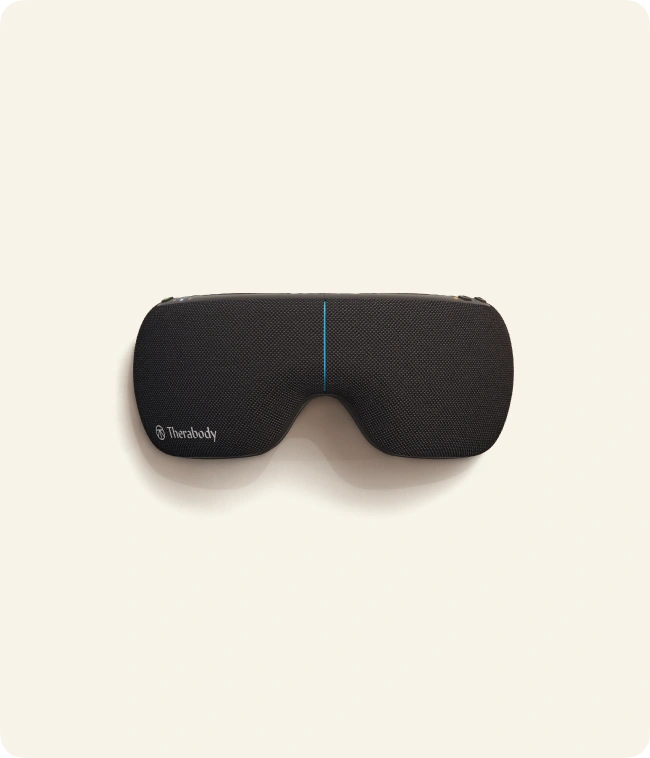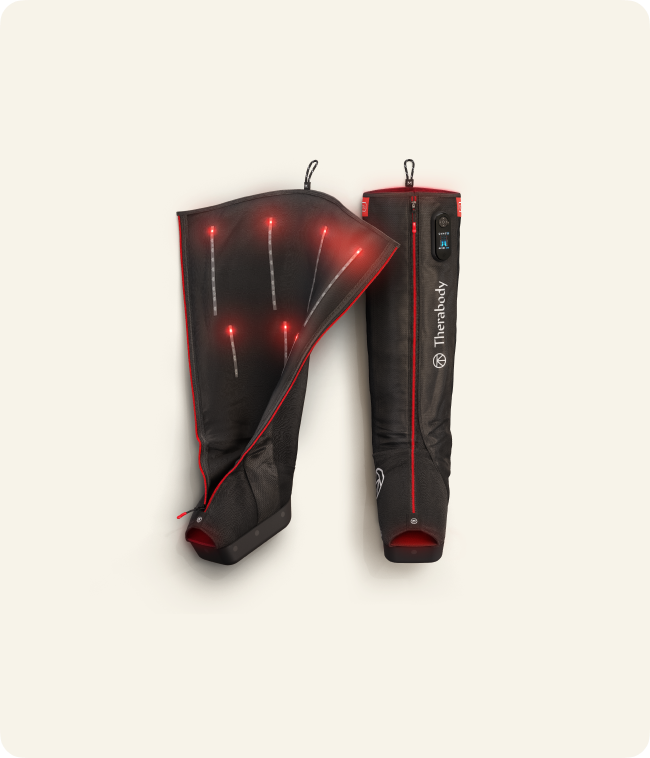
RecoveryPulse Improves Walking Speed, A Measure of Longevity, According to Recent Studies
Authors: Megan Ward, MS, CSCS; Raymond Thompson, PhD; S. Wendell Holmes, MD; Jay Patel, PhD, CPSS,*D, CSCS,*D
Reviewed by Therabody Scientists: Michelle Darian, MS, MPH, RD, LDN; Rachelle Reed, PhD, MS, ACSM-EP; Tim Roberts, MSc
They say a body in motion stays in motion — but what happens when that motion starts to feel slower, off-balance, uneven, all-around harder than it used to be?
Whether you're an athlete logging miles on the track or someone who's on your feet all day at work, these movements place constant demands on your lower body, changing how you move over time.
Vibration, a therapy that has long been recognized for relieving pain, is being studied for its ability to help improve how fast and how well we move, when used in a compressive sleeve. [1]
By stimulating muscular activity and strengthening neuromuscular control, two new pilot studies found that vibration (delivered via a compressive sleeve) can improve walking speed and gait patterns.
These benefits have the potential to extend beyond feeling better on your feet, as improved gait is linked to better fitness, heart health, and even lower mortality risk. [2]
Key definitions:
Gait: Your walking style, a complex motor skill involving connections between your limbs, brain, posture, and more. Measures of gait include walking speed and cadence, stride and step length, and asymmetries between sides.
Walking speed: How fast you move, or your walking rate.
Cadence: The number of steps you take per minute (regardless of the length of each step or how far you get).
Step length: The distance between when your right foot hits the ground and your left foot follows, essentially how far you reach with each step.
Stride length: Captures the complete cycle, from when your right foot touches down, through your left foot's contact, until your right foot lands again.
Why does how you walk matter?
Walking is likely something you do every day without thinking about it, but how you walk is an indicator of your health.
It requires cognitive control, connecting your brain and body. Studies even show that walking slower walking speeds are associated with an increased risk of death. [3, 4]
Unevenness between your left and right sides, known as asymmetries, can increase your risk of slips, trips, and falls. This creates risks for athletes who require optimal movement and older adults, who depend on functional independence. [3]
What do we already know about vibration and walking?
Researchers have long used whole-body vibration platforms in sports performance and rehabilitation settings to stimulate muscles and improve strength, power, balance, and flexibility. These platforms work by sending vibrations through the soles of your feet and up through your entire body while you stand on them. [1]
Studies in clinical populations, including people with spinal cord injuries and those in physical therapy, have shown that whole-body vibration can increase walking speed and improve cadence and gait symmetry. [5]
While effective, whole-body vibration equipment is traditionally bulky, expensive, and only available in gyms and facilities.
Now, localized vibration therapy can be delivered to specific muscle groups through portable, at-home devices like Therabody's RecoveryPulse® compression and vibration sleeve. This vibration stimulates your muscles, allowing your body to adapt and strengthen the neural pathways that control movement. [6]
So, these two new pilot studies aimed to understand how whole-body vibration compares to localized vibration when it comes to improving walking speed and gait patterns in healthy, recreationally active people.
What was the purpose of these studies?
These studies aimed to answer two questions:
1. How does applying targeted vibration to the calf (combined with compression) compare to whole-body vibration on improving walking speed and cadence?
2. How does targeted vibration improve gait outcomes, stride length and step length asymmetries compared to whole body vibration?
The studies were conducted in the Motion Analysis and Performance Lab, supported by Prisma Health, in Lexington, South Carolina, directed by Dr. Jay Patel and Biomechanics Lab Specialist Megan Ward.
Here’s how they went about testing these questions.
How were the pilot studies conducted?
The first study examined 6 participants (male and female), comparing localized vs. whole-body vibration on walking speed and cadence. The second study measured stride and step length asymmetries in 12 participants (4 male, 8 female) who were young, healthy, and recreationally active. [7, 8]
How were the studies designed?
The studies had a within-subjects design, meaning each participant received both treatments: whole body vibration and localized vibration. To control the effects that order of treatment may have on the results, half of the participants were randomly assigned to receive whole-body vibration first, while the other half received localized vibration first. Then, they switched.
What happened during the studies?
Vicon 3D motion capture, a motion analysis similar to that used in CGI movie scenes and video games, was used to obtain all measurements. Participants completed the following steps:
1. Baseline data: First, participants walked in a straight line for 8 motion capture cycles to get baseline (pre-intervention) measurements.
2. Whole body vibration or localized vibration: Next, participants completed their first vibration modality. Vibration was implemented using a 1:1 work-to-rest ratio for 5 trials between recorded gait cycles.
3. Post-intervention 1 cadence and speed data: Then, they completed a second set of 8 motion capture cycles to measure the impact of the first vibration session.
4. Washout: A ten-minute washout or “rest period” from interventions took place.
5. Whole body vibration or localized vibration: Participants then completed the second vibration modality they hadn't yet received.
6. Post-intervention 2 cadence and speed data: A final set of 8 motion capture cycles was taken.
What did the studies find?
Localized vibration and compression with RecoveryPulse significantly improved walking speed and cadence right after use, and to a greater extent than whole-body vibration. While using whole body vibration did show some improvements in walking speed and cadence, they were not statistically significant.
Looking at gait patterns, localized vibration decreased asymmetry between step length and stride lengths after use. This is favorable, as improving the symmetry between the left and right gait patterns can help to decrease the risk of slips, trips, and falls, which is crucial for maintaining independence and quality of life as we age. [4, 9]
What to take away from the studies
RecoveryPulse's localized vibration can meaningfully improve gait measures. It may do so more effectively than traditional whole-body vibration platforms, and it can be used at home or on the go.
The implications go beyond just walking faster or taking more steps per minute. Vibration may increase neuromuscular activation, offering a practical strategy for reducing fall risk and maintaining functional independence. [3]
This research bridges the gap between interventions in clinical populations and settings, and healthy, recreationally active individuals looking to make improvements. What previously required inaccessible equipment can now be integrated into your daily routine at home.
Further research is underway to study these outcomes through more in-depth testing and controlled research design parameters.
Key takeaways
- While whole-body vibration is commonly used to improve athletic performance and quality of life, localized vibration therapy may offer similar, if not more benefits in a more accessible at-home device.
- Localized vibration delivered by RecoveryPulse increased walking speed right after use to a greater extent than whole-body vibration.
- RecoveryPulse localized vibration helped reduce asymmetries between step and stride length immediately after use.
- Incorporating localized vibration into your routine may provide fitness benefits that support functional independence and quality of life.
References:
1. Effects of whole-body vibration on sports performance: A systematic review and meta-analysis
3. Gait
4. Unraveling the Association Between Gait and Mortality-One Step at a Time
5. Whole-body vibration improves walking function in individuals with spinal cord injury: a pilot study
6. Vibrations and their applications in sport. A review
7. Comparing Localized and Whole-Body Vibration on Gait Kinematics: A Pilot Study





